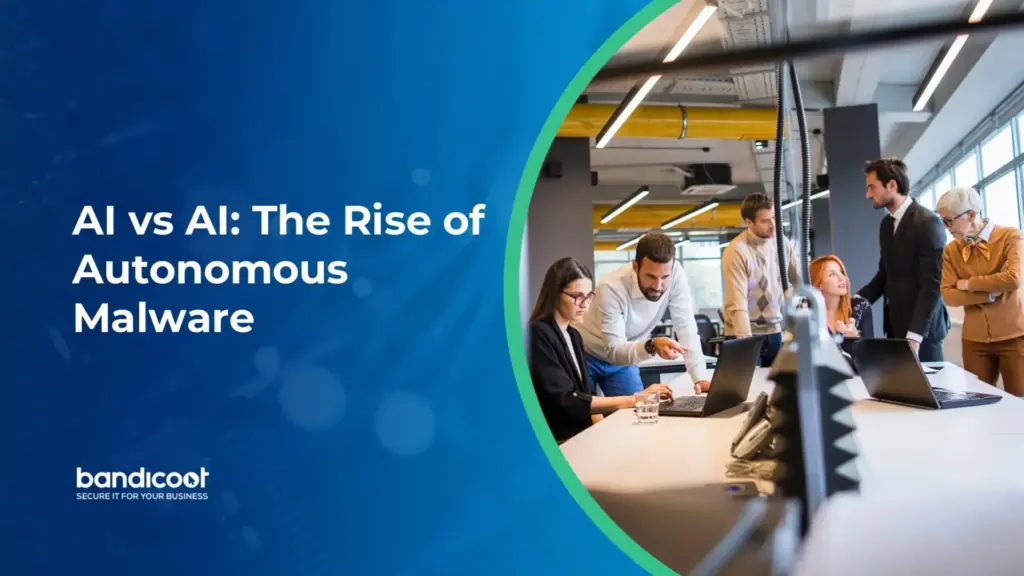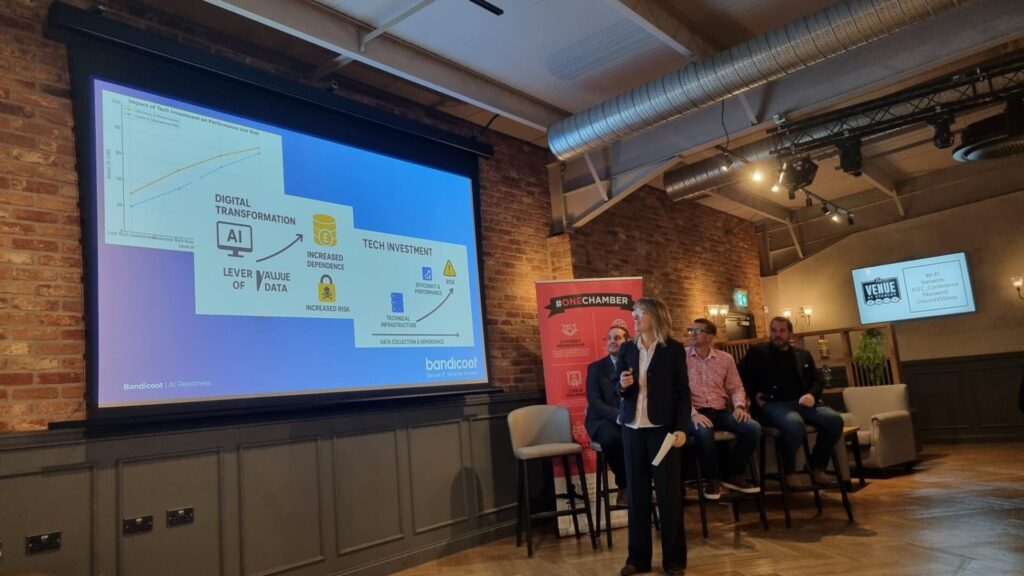
Artificial Intelligence is transforming cybersecurity in ways we never imagined – both as a powerful defence tool and an increasingly sophisticated weapon in the hands of cybercriminals. Last week, Bandicoot’s cybersecurity specialist Anjana Shukla and guest expert Arohi Naik from SQR delivered an eye-opening webinar on the emerging threat of AI-powered malware. Here are the essential insights every business leader needs to understand.
Why This Matters Now
AI-driven malware is no longer science fiction – it’s already here. Recent statistics from Bitdefender reveal that 63% of cyberattacks now incorporate some form of AI usage, with 43% showing clear AI involvement. Even more concerning, UK government reports show that four in ten businesses and three in ten charities experienced a cybersecurity attack in the last 12 months.
The reality is stark: cybercrime is scaling rapidly, and AI is the force multiplier making it possible.
Understanding AI Malware: What It Actually Is
Contrary to popular belief, AI doesn’t always create malware from scratch. Instead, Large Language Models (LLMs) act more like sophisticated collaborators than creators, enhancing traditional attack methods in three key ways:
Social Engineering
AI crafts highly realistic phishing emails that sound like they’re from your boss, your bank, or even a loved one. These messages are becoming so convincing that traditional “sniff tests” for spotting fake communications are failing.
Payload Polymorphism
AI helps malware constantly rewrite its code, making it virtually undetectable by traditional antivirus software. The malware can literally change its appearance faster than security tools can recognise it.
Obfuscation and Sandbox Evasion
AI enables malware to hide in plain sight, even evading sophisticated security systems designed to analyse threats in controlled environments.
Current Threats Already in the Wild
Several AI-powered threats are already active and causing real damage:
BlackMamba: A proof-of-concept keylogger that uses GPT-generated payloads in real-time, leaving no static files for antivirus software to detect.
EyeSpy: Android malware that uses LLM-generated fake security updates to infiltrate devices, appearing legitimate whilst containing malicious payloads.
FraudGPT & WormGPT: Dark web LLMs with no ethical limits, specifically designed to generate scam campaigns, phishing attempts, and malware.
Deepfake Fraud: Perhaps most alarmingly, voice-cloned CEO scams have already resulted in losses of $25 million, demonstrating the real-world financial impact of AI-powered social engineering.
Emerging Experimental Threats
Even more concerning are the experimental AI malware models currently being tested:
- Morris II Worm: Demonstrates how AI can help malware spread autonomously
- Autonomous AI Malware Agents: Red team concepts showing AI that can plan and execute attacks independently
- LLM Supply Chain Attacks: Malicious code slipped into software via API misuse
- Plugin-Based Payload Injection: Hijacking AI tool plugins through clever prompt manipulation
The New Weapon: Prompt Injection
One of the most insidious developments is prompt injection – where malicious instructions are hidden in what appears to be normal text. Using techniques like jailbreaks and prompt chaining, attackers can weaponise prompts themselves, requiring no traditional code whatsoever.
Malware-as-a-Service Gets an AI Upgrade
The professionalisation of cybercrime has reached new heights with AI-enhanced Malware-as-a-Service operations. These criminal enterprises now offer:
- Pre-written phishing scripts localised by LLMs
- Voice cloning services for social engineering
- AI chatbots for ransomware negotiations
- Full-service dark web “malware startups” with customer support
Disturbingly, these operations function like legitimate businesses, complete with help desks and service level agreements for their criminal services.
What Makes AI Malware Uniquely Dangerous
Four factors make AI-powered attacks particularly threatening:
Speed: Code, lures, and documents can be generated in seconds rather than hours or days.
Personalisation: Attacks are increasingly tailored to specific individuals and organisations.
Scale: A single attacker can now target thousands of victims simultaneously.
Believability: AI-written content is becoming indistinguishable from human-created communications.
Government Response and Regulation
Governments are beginning to respond to this threat:
EU: The new AI Act classifies harmful or manipulative AI (including malware and deepfake scams) as “high risk,” requiring businesses to prove their AI systems are safe before deployment.
UK: While no specific legislation exists yet, the government and National Cyber Security Centre (NCSC) are actively warning businesses that AI-generated scams and phishing represent an immediate threat requiring preparation now.
Protecting Your Business: Practical Steps
The good news is that defence is possible. Here’s what businesses should do immediately:
1. Upgrade Your Security Technology
- Implement EDR (Endpoint Detection and Response) or XDR (Extended Detection and Response) tools with AI-detection capabilities
- These systems use AI to spot suspicious behaviour patterns, even from previously unknown threats
- Traditional antivirus software that only recognises known threats is no longer sufficient
2. Foster Healthy Scepticism
- Train staff to be cautious of realistic voice and video messages – just because it sounds like your CEO doesn’t mean it is
- Establish verification procedures for unusual requests, especially those involving financial transactions
- Be particularly wary of urgent requests that bypass normal approval processes
3. Control AI Tool Usage
- Avoid untrusted AI tools and browser plugins, which are becoming common backdoors for malware
- Establish clear policies about which AI tools employees can use for business purposes
- Be aware that sharing personal or business information with AI tools may make that data public
4. Enhanced Staff Training
- Educate your team about AI-generated phishing attempts
- While the tone and grammar may be perfect, staff can still learn to identify suspicious intent
- Regular awareness training is essential as threats evolve rapidly
5. Treat Prompt Injection Seriously
- If your team uses AI tools, understand that even simple messages can be weaponised
- Implement controls around how AI tools are used within your organisation
The Reality Check: We Still Have Time
Despite the alarming developments, there’s still reason for cautious optimism. AI malware hasn’t yet been mass-deployed on a large scale. However, the tools, templates, and criminal marketplace are already in place and ready for wider adoption.
The key is preparation. Understanding these threats puts your business ahead of 95% of organisations. Your current security tools don’t need to go in the bin immediately – they still provide valuable protection. However, businesses must adopt a layered security approach and consider outsourcing cybersecurity to specialists if they lack internal expertise.
Next Steps for Your Business
- Schedule a free cybersecurity audit to understand your current vulnerabilities
- Consider Cybersecurity as a-Service if you lack internal expertise
- Pursue relevant accreditations like Cyber Essentials to demonstrate your commitment to security
- Schedule a discovery call with Stuart to develop a comprehensive protection strategy
Final Thoughts
The cybersecurity landscape is evolving at breakneck speed. AI-powered attacks represent a significant escalation in both the sophistication and scale of threats facing businesses today. However, by staying informed, sceptical, curious, and adaptive, organisations can build robust defences against these emerging threats.
The race between AI-powered attacks and AI-enhanced defences is just beginning. The businesses that take proactive steps now will be best positioned to thrive in this new landscape.
If you’re concerned about your business’s cybersecurity posture, Bandicoot offers comprehensive IT support packages with advanced cybersecurity protection. Contact us at 01282 506 617 or support@bandicoot.co.uk to schedule a free security audit and discover how we can help protect your business from the evolving threat landscape.



